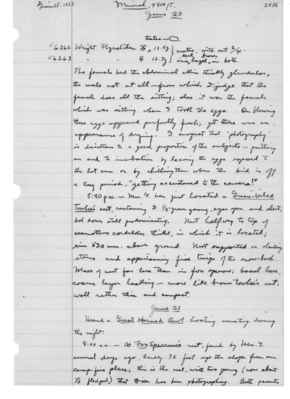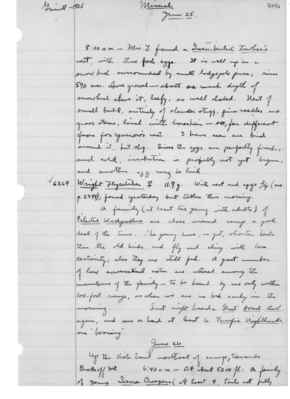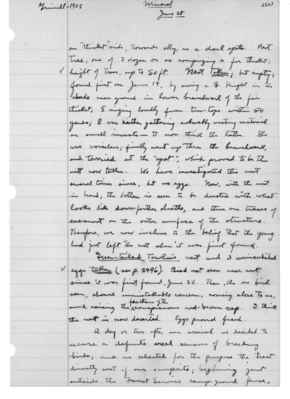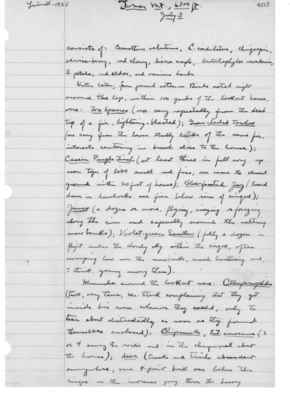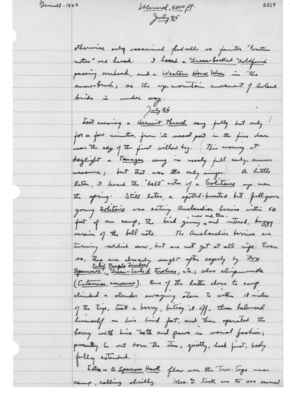Pages That Mention Green-tailed Towhee
1925: Joseph Grinnell's field notes
S2 Page 31
Collector: Grinnell-1925 Location: Mineral, 4800 ft., Date: June 20 Page Number: 2486
6262 Wright Flycatcher (male) ^testes [illustration] 12.5 g 6263 [Wright] [Flycatcher] (female) 12.7 g } mates, with set 2/4. iris ^dark hazel ^brown in both.
The female had the abdominal skin thickly glandular, the male not at all - from which I judge that the female does all the sitting; also it was the female which was sitting when I took the eggs. On blowing these eggs appeared perfectly fresh; yet there was an appearance of drying. I suspect that "photography" is disastrous to a good proportion of the subjects - putting an end to incubation by leaving the eggs exposed to the hot sun or by chilling them when the bird is off a long period, "getting accustomed to the camera!"
5:40 p.m. - Mrs. G. has just located a Green-tailed Towhee's nest, containing 3 1/3-grown young, eyes open and alert, but down still predominating. Nest halfway to top of ceanothus cordulatus thicket, in which it is located; rim 520 mm. above ground. Nest supported on slanting stems and appertaining fine twigs of the snow-bush. Mass of nest far less than in fox sparrow; basal loose, coarse layer lacking - more like brown towhee's nest; wall rather thin and compact.
June 21 Heard a Great Horned Owl hooting something during the night.
8:00 a.m. - At Fox Sparrow's nest, found by Mrs. G. several days ago, hardly 75 feet up the slope from our camp-fire place; this is the nest, with two young (now about 1/3 fledged) that Dixon had been photographing. Both parents
S2 Page 42
Collector: Grinnell - 1925 Location: Mineral Date: June 25 Page Number: 2496
8:00 a.m. - Mrs. G. found a Green-tailed Towhee's nest, with three fresh eggs. It is well up in a snow bush surrounded by small lodgepole pines; rim 590 mm. above ground - about as much depth of snowbush above it, leafy, so well shaded. Nest of small bulk, entirely of slender stuff, pine needles and grass stems, lined with horsehair - so, far different from fox sparrow's nest. I have seen one bird around it, but shy. Since the eggs are perfectly fresh, and cold, incubation is probably not yet begun, and another egg may be laid.
6264 Wright Flycatcher [female symbol] 11.9 g. With nest and eggs 3/4 (see p. 2494); found yesterday but taken this morning.
A family (at least two young with adults) of Pileated Woodpeckers are close around camp a good deal of the time. The young have, as yet, shorter tails than the old birds, and fly and cling with less certainty; also they are still fed. A great number of low conversational notes are uttered among the members of the family - to be heard by us only within 100-foot range, as when we are in bed early in the morning. Last night heard a Great Horned Owl again, and saw or heard at least 6 Pacific Nighthawks, one "booming".
June 26 Up the Vista Trail northeast of camp, towards Brokeoff Mt. 6:40 a.m. - At about 5200 ft.: A family of young Sierra Creepers (at least 4, tails not fully
S2 Page 49
Collector: Grinnell - 1925 Location: Mineral Date: June 28 Page Number: 2503
on "thicket" side, towards sky, as a dark spot. Nest tree, one of 2 dozen or so comprising a fir thicket; height of trees, up to 50 ft. Nest taken; but empty; found first on June 14, by seeing a [female symbol] Kinglet inthe shade near ground in lower branchwork of the fir thicket; [male symbol] singing loudly from tree-tops within 50 yards; [female symbol] was either gathering cobwebby nesting material or small insects - I now think the latter. She was voiceless; finally went up thru the branchwork, and tarried at the "spot", which proved to be the nest now taken. We have investigated this nest several times since, but no eggs. Now, with the nest in hand, the bottom is seen to be dusted with what looks like down-feather sheaths, and there are traces of excrement on the outer surface of the structure. Therefore, we now incline to the belief that the young had just left the nest when it was first found.
Green-tailed Towhee's nest and 3 unincubated eggs taken (see p. 2496). Bird not seen near nest since it was first found, June 25. Then, the one bird seen, showed unmistakable concern, coming close to me, and raising the ^feathers of the conspicuous red-brown cap. I think the nest is now deserted. Eggs proved fresh.
A day or two after our arrival we decided to secure a definite areal census of breeding birds; and we selected for the purpose the tract directly west of our campsite; beginning just outside the Forest Service camp-ground fence,
S2 Page 64
Collector: Grinnell - 1925 Location: Turner Mt., 6300 ft. Date: July 3 Page Number: 2517
consist of: Ceanothus velutinus, C. cordulatus, chinquapin, service-berry, red cherry, Sierra maple, Arctostaphylos nevadensis, A. patula, red alder, and various herbs.
Written later, from pencil notes. - Birds noted right around the top, within 100 yards of the lookout house, were: Fox Sparrow (one sang repeatedly from the dead tip of a fir, lightning-blasted); Green-tailed Towhee (one sang from the lower stubby limbs of the same fir, interests centering in the brush close to the house); Cassin Purple Finch (at least three in full song up near tops of live small red firs, one came to cleared ground within 20 feet of house); Blue-fronted Jay (heard down in the hemlocks and firs below rim of cirque); Junco (a dozen or more, flying, singing or foraging along the rim and especially around the melting snow banks); Violet-green Swallow (fully a dozen in flight under the cloudy sky within the cirque, often swooping low over the snowbanks, much twittering and, I think, young among them.
Mammals around the lookout were: Callospermophilus (two, very tame, Mr. Stark complaining that they got inside his room whenever they could, only to tear about distractedly as soon a they found themselves enclosed), Chipmunks, Eut. amoenus (3 or 4 among the rocks and in the chaparral about the house); deer (tracks and tails abundant everywhere, one 4-point buck seen below the cirque on the moraines going thru [sic] the heavy
S2 Page 76
Collector: Grinnell - 1925 Location: Mineral, 4800 ft. Date: July 25 Page Number: 2529
otherwise only occasional food calls or fainter "location notes" are heard. I heard a Green-backed Goldfinch passing overheard, and a Western House Wren in the snow-brush; so the up-mountain movement of lowland birds is under way.
July 26 Last evening a Hermit thrush sang fully but only for a few minutes, from its usual post in the firs down near the edge of the first willow bog. This morning at daylight a Tanager sang in nearly full early summer measure; but that was the only singer. A little later, I heard the "bell" notes of a Solitaire up near the spring. Still later, a spotted-breasted but full-grown young Solitaire was eating Amelanchier berries within 50 feet of our camp, the bird giving ^now and then an intoned, buzzy version of the bell note. The Amelanchier berries are turning reddish now, but not yet at all ripe. Even so, they are already sought after eagerly by Fox Sparrows, ^Calif. Purple Finches, Green-tailed Towhees, etc; also chipmunks (Eutamias amoenus). One of the latter close to camp climbed a slender swaying stem to within 18 inches of the tip, took a berry, biting it off, then balanced himself on his hind feet, and then operated the berry with his teeth and paws in usual fashion; presently he went the stem, quietly, head first, body fully extended.
Later - A Sparrow Hawk flew over the tree-tops near camp, calling shrilly. Mrs. G. took me to see several
